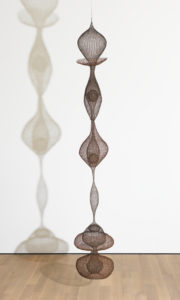![]()
Sol LeWitt, Wall Drawing 273, September 1975; The Doris and Donald Fisher Collection at the San Francisco Museum of Modern Art; ©️ The LeWitt Estate / Artists Rights Society (ARS), New York; photo: Ian Reeves
Key Concepts
- Shape, color, and line
- Materials and process
- Idea as artwork
Materials
- 9” x 12” white construction paper with a grid drawn on it (squares can be 3” x 3”)
- Red, yellow, and blue markers, colored pencils, or crayons
- Ruler or straight edge
Introduction
- What was the first thing you noticed about this work? Why do you think you noticed that first?
- Do you notice more about the work after looking at it for a while? What do you see now?
- Describe the lines, shapes, and colors you see.
- These wall drawings were based on a set of instructions/directions. What do you think some of the directions might have been?
Instructions
Sol LeWitt did many wall drawings during his career. Now that he is no longer alive, other people have to follow his instructions to “install” his works. Let’s see if we can follow a set of Sol LeWitt’s wall drawing instructions to create our own drawing.
- Take your white paper with the grid of 3” x 3” squares.
- Read the instructions for LeWitt’s Wall Drawing below.
- Using red, yellow, and blue markers, pencils, or crayons, follow the steps for the Seventh wall.
Sol LeWitt’s Wall Drawing 273, September 1975
Graphite and crayon on seven walls
A 6” (15 cm) grid covering the walls. Lines from corners, sides, and center of the walls to random points on the grid.
1st wall: Red lines from the midpoints of four sides;
2nd wall: Blue lines from the four corners;
3rd wall: Yellow lines from the center;
4th wall: Red lines from the midpoints of four sides, blue lines from four corners;
5th wall: Red lines from the midpoints of four sides, yellow lines from the center;
6th wall: Blue lines from four corners, yellow lines from the center;
7th wall: Red lines from the midpoints of four sides, blue lines from four corners, yellow lines from the center.
Each wall has an equal number of lines. (The number of lines and their length are determined by the draftsman.)
Relevant Information
LeWitt helped revolutionize the definition of art in the 1960s by stating that the idea for an artwork is more important than its form. Each of his impermanent wall drawings consists of a set of the artist’s instructions, with the actual execution carried out by someone else. LeWitt compared his instructions to musical scores, which are realized in a new way every time they’re played. Similarly, it’s possible for LeWitt’s wall drawings to take slightly different forms, depending on how his directions are implemented.
Discussion
- Think about what you learned from looking at the work and using LeWitt’s instructions to create your own instruction work.
- What did you discover about the work?
- Why did you make the choices that you did?
